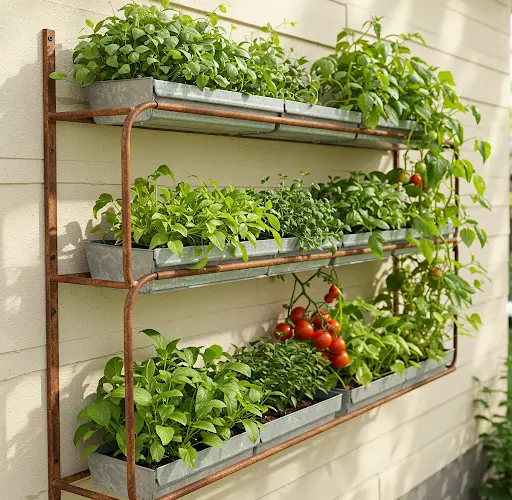Take Advantage of the Railing to Grow Vegetables for Your Family
Growing fresh vegetables at home is a great way to ensure a healthy diet, but not everyone has the space for a traditional garden. If you have a balcony or patio with a railing, you can turn it into a productive vegetable-growing space. This method allows you to maximize your available area while providing fresh and nutritious food for your family. Here’s how you can take full advantage of your railing to grow vegetables efficiently and effectively.
1. Choose the Right Vegetables for Railing Gardens
Not all vegetables are suitable for railing gardening. Some require deep soil, while others thrive in shallow containers. The best choices for railing gardens include:
- Leafy Greens: Lettuce, spinach, kale, and arugula grow quickly and don’t need deep soil.
- Herbs: Basil, mint, parsley, cilantro, and chives thrive in small spaces and add great flavor to meals.
- Climbing Vegetables: Beans, peas, and cucumbers can grow vertically using the railing for support.
- Cherry Tomatoes: Small tomato varieties do well in hanging baskets or railing planters.
- Radishes & Green Onions: These root vegetables require little space and grow fast.
By selecting the right vegetables, you can maximize your railing garden’s productivity.
2. Selecting the Best Containers
Choosing the right containers is crucial for growing healthy plants. Here are some great options for railing gardens:
- Hanging Baskets: Ideal for trailing plants like cherry tomatoes and strawberries.
- Railing Planters: These attach securely to railings and are perfect for herbs and leafy greens.
- Vertical Planters: Stackable or wall-mounted planters allow you to grow more in less space.
- DIY Recycled Containers: Use old buckets, wooden boxes, or plastic bottles for an eco-friendly solution.
Make sure your containers have proper drainage holes to prevent waterlogging.
3. Setting Up Your Railing Garden
Once you have your vegetables and containers, it’s time to set up your railing garden. Follow these steps:
Step 1: Secure Your Planters
Ensure that railing planters and hanging baskets are firmly attached to prevent accidents. Use sturdy hooks, brackets, or straps to keep them in place.
Step 2: Use Quality Soil
A good potting mix rich in organic matter will help your vegetables thrive. Avoid using regular garden soil, as it may not drain well in containers.
Step 3: Water Regularly
Container plants dry out faster than those in the ground. Water daily in warm weather but avoid overwatering.
Step 4: Provide Sunlight
Most vegetables need at least 6 hours of sunlight per day. Position your containers on the sunniest part of the railing.
Step 5: Use Vertical Supports
For climbing plants like beans and cucumbers, install trellises or netting along the railing to encourage upward growth and save space.
4. Maximizing Productivity in Small Spaces
To get the most out of your railing garden, follow these tips:
- Succession Planting: Plant new seeds every few weeks to ensure a continuous harvest.
- Companion Planting: Grow complementary plants together, such as basil with tomatoes or lettuce with radishes, to improve growth and deter pests.
- Prune Regularly: Trim dead leaves and encourage bushier growth to maximize space.
- Use Organic Fertilizer: Apply compost or organic liquid fertilizer to nourish your plants naturally.
5. Protecting Your Railing Garden from Pests and Weather
Since railing gardens are exposed, they may be vulnerable to pests and harsh weather conditions. Here’s how to keep your plants safe:
- Cover with Netting: Protect plants from birds and insects by using fine mesh netting.
- Move Indoors During Storms: If possible, bring containers inside during extreme weather.
- Use Mulch: Add a layer of mulch to retain moisture and protect roots from temperature fluctuations.
- Natural Pest Control: Use neem oil, garlic spray, or introduce beneficial insects like ladybugs to keep pests at bay.
6. Harvesting and Enjoying Your Homegrown Vegetables
One of the best parts of growing your own vegetables is harvesting them fresh from your railing garden. Here’s how to enjoy your bounty:
- Harvest Frequently: Pick leafy greens and herbs regularly to encourage new growth.
- Use Fresh in Meals: Add freshly harvested vegetables to salads, soups, and smoothies.
- Preserve the Extra: Dry herbs, pickle cucumbers, or freeze excess vegetables for later use.
Conclusion
You don’t need a large backyard to grow fresh, healthy vegetables. By utilizing your railing, you can turn a small space into a productive garden that provides nutritious food for your family. With the right vegetables, containers, and care, your railing garden can thrive and give you a steady supply of homegrown produce. Start today and enjoy the benefits of fresh, organic vegetables right outside your door!



